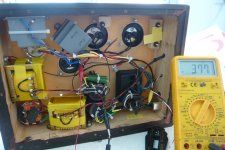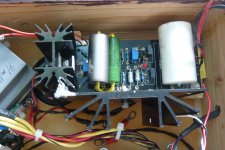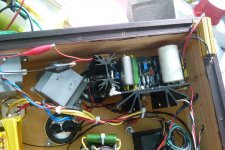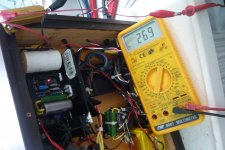Advise is you will need a transformer with two discrete same secondaries, i.e. 4 wires not 3 to make the two positive regs configuration. Milliamps and Volts is whatever your application specifies plus 20mA for the regs. Double that to be royal if you can. Keep in mind about AC*1.33 real DC value to expect after rectification. Make sure it will allow 20V headroom to the regulators.
Sorry for my equivocation,
Two transformers Hammond model 369AX, 40 Va Power and 250V and 115miliamperios SEC.
I was wrong with a transformer I have for other applications.
Best Regards.
Those will give ~330VDC with solid state bridge rectification and loaded by the reg's CCS.
You should consider enough RC to drop about 100V @ CCS current consideration level before the regs for your +/-200V that I saw on your posted drawing.
You should consider enough RC to drop about 100V @ CCS current consideration level before the regs for your +/-200V that I saw on your posted drawing.
True, but he could also use another model 363AX, that is 200V 115 Milliamp, and once past the bridge rectifier would give us about 280V.Those will give ~330VDC with solid state bridge rectification and loaded by the reg's CCS.
You should consider enough RC to drop about 100V @ CCS current consideration level before the regs for your +/-200V that I saw on your posted drawing.
This model would be more advisable?
More like 265V before RC, yes more advisable for less drop & heat, also smaller wattage R in the RC.
I measured last night, with a 22K/50W parallel with one 10K/50W, the voltage across was 286V on start up; and went to 288V after 3-5 minutes (the 10K also gets a bit hot).If you will test with the bleeder installed plus one 10K that will indicate 42mA capability at the voltage it will settle. If that will be 285V or more, remove both resistors, connect the reg and set it to 40mA. install a 150K 2W bleeder if you got or get one to install later where the 22K was for capacitor bank exposed legs to be HV safe after turn off.
Next week, I will remove the 22K and the 10K, and connect to test the SSHV2....
Could you please explain how you can calculate and predict that when I remove one 10K from the dummy load I used before, that we will get 286V??
Cheers,
King
Yes, I know....Ohm's law must be part of it.....but with Ohm's law, to calculate the V, you need to be given R and I.....given only R, how can you predict V and I??...what is the logic behind it???
yes...my question should be: how could I use those ball park data to predict even a ball park figure for V and I given only R.....
You gave two rectified voltages for two Ohmic loads. Those give two points of current also.
So there shows a poor for data pattern of drop that you can roughly extrapolate some expectation for another lighter load demand.
So there shows a poor for data pattern of drop that you can roughly extrapolate some expectation for another lighter load demand.
but you got it down so nice and exact......
And in the future if I like to try to set the CCS to load the tube at say 15mA each.....do I need to modify the PSU??
And in the future if I like to try to set the CCS to load the tube at say 15mA each.....do I need to modify the PSU??
If it will stay then at least +10V than output for 50mA CCS at your lowest mains expected, don't modify it.
Salas, ECC81 mu-follower with AZ1 + SSHV2 sounds superb, extraordinary voices with very good bass. With SS rectifiers loss all the magic.
If it will stay then at least +10V than output for 50mA CCS at your lowest mains expected, don't modify it.
Final testing of new PSU with 150K bleeder only. V out = 377V
Attachments
Salas, ECC81 mu-follower with AZ1 + SSHV2 sounds superb, extraordinary voices with very good bass. With SS rectifiers loss all the magic.
OK, keep it with AZ1 as set.
- Home
- Amplifiers
- Power Supplies
- Simplistic mosFET HV Shunt Regs



